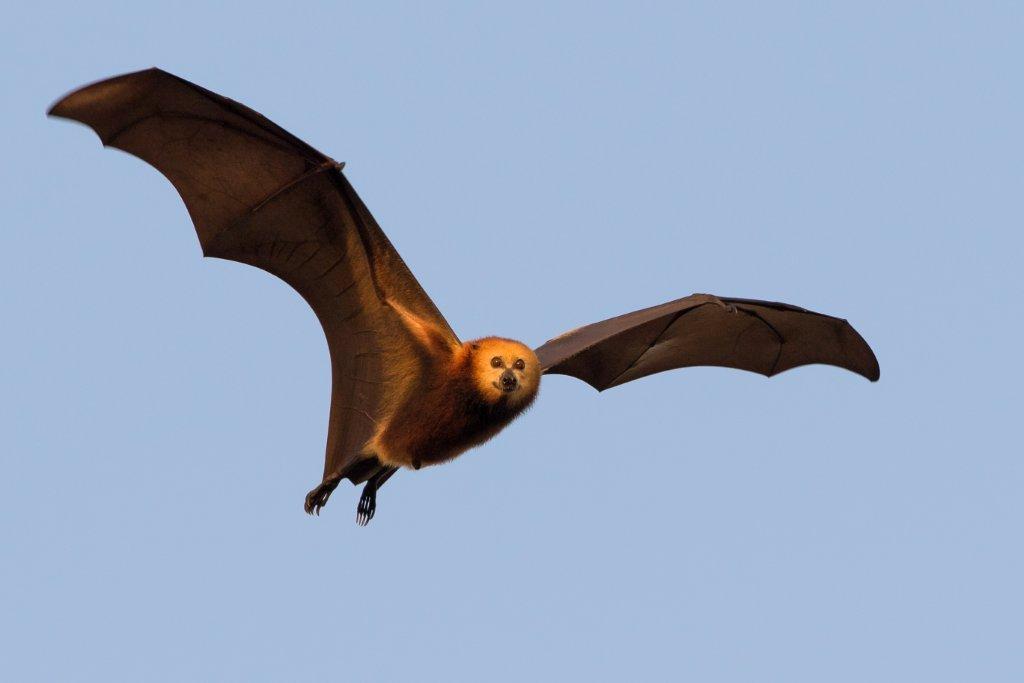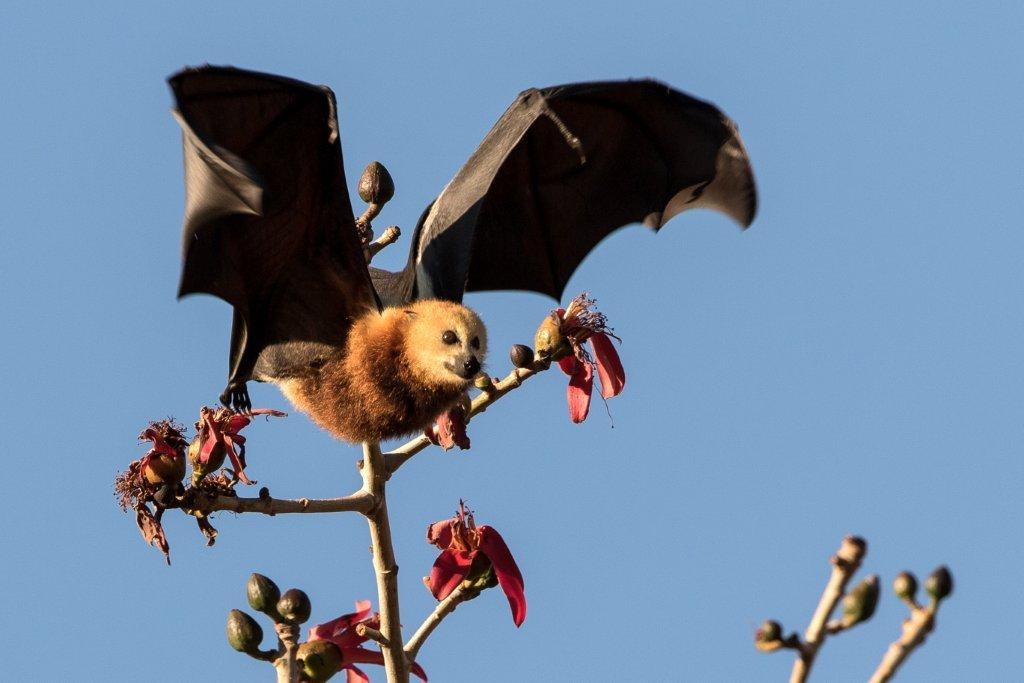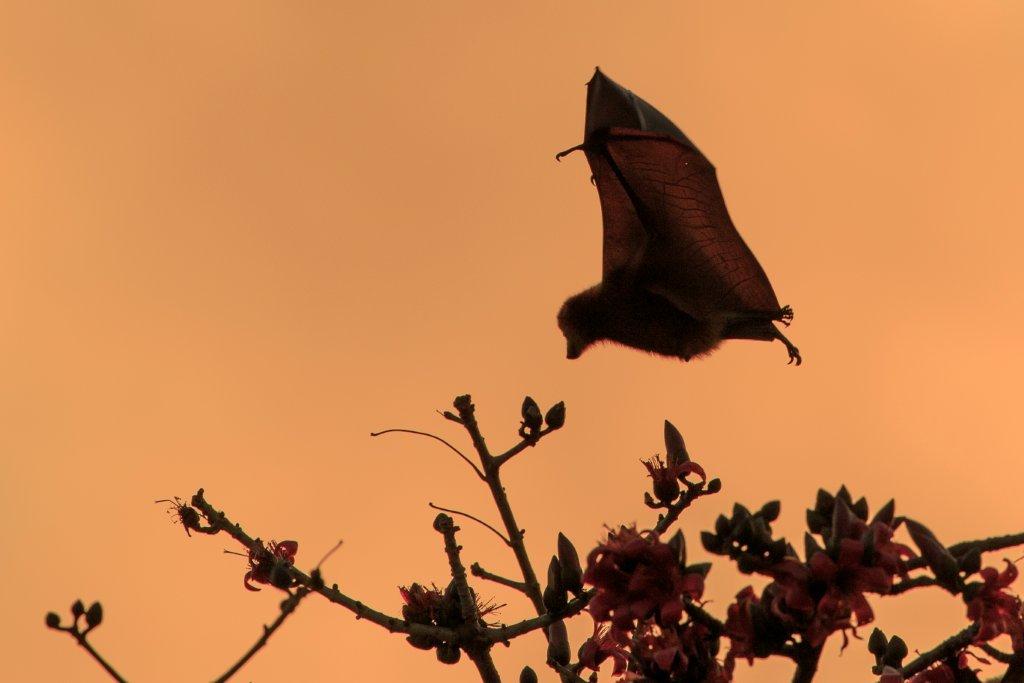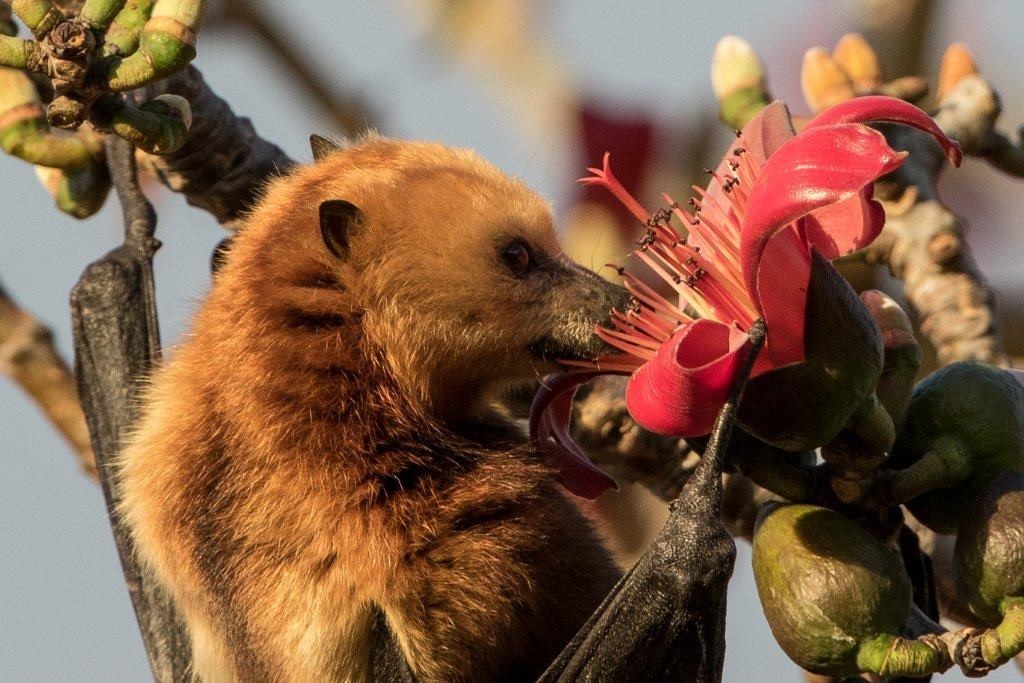
IUCN status from Endangered to Vulnerable in 2014
© Jacques de Speville
|
| |
| |

Bats are large pollinators
© Jacques de Speville
|
| |
| |

Bat population is not growing any further because of habitat and food limitations
© Jacques de Speville
|
| |
| |

Bats are the only mammals native to the Mascarene Island
© Jacques de Speville
|
|
| |
| |
| |
| |
| |
| |
| |
| |
| |
| |
|
Bats are the only mammals native to the Mascarene Islands. Once there were three fruit bat species, one is now extinct, leaving one species each on Mauritius (Pteropus niger) and Rodrigues (P. rodricensis). Once widespread over Mauritius, the Mauritius Fruit Bat population has decreased considerably due to habitat loss, cyclones and illegal sport hunting. Although this bat became extinct on Reunion, where it was last recorded in 1790, the island has been recolonized by a handful of individuals over the last decade.
Due to lack of major cyclones for over a decade, the population of Mauritius Fruit Bat population has increased, thus shifting its IUCN status from Endangered to Vulnerable in 2014, which was also based on an assurance that culling would not be considered. The bat survey done by the National Parks and Conservation Service (NPCS) in 2015 was based on a disturbance count which is known to lead to double counting (i.e. bats are disturbed to take off, counted while flying, they move from the counted roost to another one which is later also counted). Mauritian Wildlife Foundation estimated that the population would be around 50,000 individuals.
In November 2015, the government introduced a new act, the Native Terrestrial Biodiversity And National Parks Act (repealing the previous Wildlife and National Park Act 1994). This legalised the culling of Mauritius Fruit Bats on the basis that they were considered as major pest to exotic fruit plantations. The Mauritian Wildlife Foundation along with IUCN’s Bat Specialist Group and a host of bat protection organisations, including Bat Conservation International, had been providing scientific and management advice to the Government to convince them that the culling could have catastrophic effects on the bat population in Mauritius and was not an effective method to protect fruit crops. A cull began officially on the 7th of November 2015 and lasted until mid December 2015. The process was not transparent and the numbers killed is subject to debate. In addition to the cull there were other causes of mortality, such as electrocution, entanglement in nets and illegal hunting.
In October 2016 a bat population estimate has been undertaken by the NPCS in collaboration with the Forestry Service and the Mauritian Wildlife Foundation, using more accurate methods of counting: Evening Dispersal Counts and Direct counts. The figure arrived at was 62,500 (± 7%) Mauritius Fruit Bats.
Regretfully a cull was announced on 8th December 2016 for a period of two weeks. The process was not transparent but appeared to focus culling in areas where fruit bats were causing the greatest impact on either backyard fruits (e.g. Reduit) or in orchards following requests from owners (a lot of orchards had taken up netting). The government reported that 7,380 bats were officially culled in 2016. These official cull figures from 2015 and 2016 do not take into account illegal hunting and persecution of bats and electrocution on powerlines. Taking into account all mortalities and that the Red List status was moved to Vulnerable based on an assurance that culling would not take place, the International Union for the Conservation of Nature (IUCN) has been re-assessing the Red List status of the Mauritius Fruit Bat to uplist from Vulnerable to Endangered, which will reflect a higher degree of threat of extinction.
Fruit growers in Mauritius have been claiming that bats cause all the damage to their lychee and mango crops. In recent years the extent to which fruit bats take lychees in comparison to other fruit eaters (such as the Ring-necked Parakeet, Common Mynah, Red-whiskered Bulbul, and rats) has been assessed. The Mauritius Fruit Bat is considered by the general public as a major pest to exotic fruit crops, mainly litchis and mangos, although the real extent of their damage to these fruit crops has only recently been studied. (Dr Ryszard Oleksy/MWF 2014/2015, 2015/2016: North of England Zoological Society/MWF 2016/2017). The Mauritian government reported 42% to 73% damage to litchis and mangos attributed to bats, but ignored the fact that damage to fruits are also caused by introduced birds, winds and diseases. The post-doctoral study on the damage that bats cause to litchi, longan and mango trees shows that damage is on average around 20% and that there are geographical and inter-annual variation in the extent of damage.
In 2009, a positive step was taken when the Government carried out a sensitization campaign for the protection of farmed fruit and promoted the use of nets to protect fruit from bats and birds, along with a grant scheme to purchase the nets, which was extended into 2017. The nets, if lifted from the tree and sealed to prevent birds accessing the tree, is a very effective way of protecting the fruit. (Protection of Fruit 2017-Download pdf). We encourage the Government to continue with this scheme and to provide advice and support to growers to net their trees, promote pruning of trees and the propagation of dwarf fruit trees which will improve fruit protection and ease of harvesting.(Pruning Fruit Trees-FAREI-Download pdf).
In recognition that there is a human-wildlife conflict concerning the Mauritius Fruit Bat, MWF approached the North of England Zoological Society (Chester Zoo) who have experience in these conflicts to work with us on the strategies needed to address the situation. Information has been gathered from meeting with stakeholders affected (orchard owners, back yard growers, fruit sellers etc) and via a questionnaire survey. The first action identified from the initial findings was to hold a netting workshop
In August 2017, MWF organised a ‘Netting Workshop’ in collaboration with the Ministry of Agro-Industry and Food Security, Chester Zoo (UK) and the IUCN. This workshop was attended by fruit farmers and received technical advice of farmers and researchers from Australia and Thailand. Recommendations were provided for pruning of trees, netting, equipment and subsidies in a multi-stakeholder workshop held in August 2017. See full report here.
The second action held under the human-wildlife conflict project was a research workshop in May 2018. The aim of the workshop was to share and disseminate to all organisations and individuals involved or interested in research into the Mauritius Fruit Bat, covering conservation, agriculture, extension, animal welfare both locally and internationally.
The results of research that had been carried out or was ongoing were discussed and the workshop identified future research priorities. See full report here.
The Mauritian Wildlife Foundation has also set up a Bat Education project on Mauritius, funded by The Rufford Foundation (UK). This project aims to: promote the awareness amongst Mauritian people about the levels of damage that bats actually cause to fruit production, the value of bats to the ecosystems, the advantages of pruning trees and netting, our opposition to culling and promoting a positive image of bats. This project works along with the human-wildlife conflict actions.
In July 2018 the IUCN up-listed the Mauritius Fruit Bat on the Red List to Endangered as a direct result of the culling carried out in 2015 and 2016. Read MWF's statement "The Mauritius Fruit Bat uplisted as endangered by IUCN".
Read also the IUCN SSC Position Statement on the Culling of theMauritius Fruit Bat Pteropus niger 2018.
On the 26th October 2018 the Government of Mauritius announced there would be cull of the Mauritius Fruit Bat with immediate effect. The population is estimated at 65,000 and a 20% cull is authorised which makes 13,000 bats.
For more information please click here.
The Mauritian Wildlife Foundation has made a 10 minute educational film ‘Mauritius Fruit Bat under Threat’ in the context of the current Human Wildlife Conflict to explain why this has arisen and why it is important to protect the Bat.
watch video.
 -How to net a tree brochure. -How to net a tree brochure.
For more information and updates on the Mauritian Fruit Bat, see the relevant topics below;
|
|